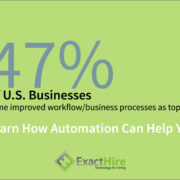What are the Phases of Onboarding?
Onboarding is your secret weapon for attaining all sorts of goals for your business. For example, taking the time to make the best impression for new hires can help increase employee retention. Having a well-rounded training plan in place can catapult your new employee from lumbering novice to an agent of productive wizardry. The onboarding process can help you take the helm of your company’s culture to increase collaboration and reduce petty grumblings.
Small to medium-sized businesses often neglect the onboarding process at their peril. But realizing the potential of onboarding requires thoughtful planning. Taking new hires on the journey from clumsy newcomer to accomplished contributor calls for a phased onboarding plan.
Employee Onboarding Process Stages
You may find yourself saying “I hate the term onboarding” once you really take a deep dive into how you can make this process better. But I assure you, if you don’t take control of your new employees’ experience, your organization will suffer.
A good onboarding definition is simply the process of introducing your new employee into the organization. Employee onboarding can help your organization reach its financial goals, and that prospect is maximized when you create a phased plan for this important process.

There are six stages to employee onboarding. The first is project management, during which you plan and break down the steps for onboarding your new hire.
The second is preparation and pre-boarding. During this phase, you complete your background checks and brief the staff who will be taking part in the onboarding process. You’ll also communicate with your new hire to help ease lingering doubts about his new position.
Next is the tedious, yet necessary step, that you’re already familiar with: new hire paperwork. Employee onboarding software can help you easily crank out this administrative detail while saving time and reducing errors.
The fourth step is new employee orientation, followed by new employee training. During this phase, your new hire will be introduced to your organization’s structure and will learn how he fits in.
Finally, the last step, reviewing productivity and performance, will help you assess the success of the previous steps.
Process Project Management
In many ways, bringing in new hires and helping them evolve into productive and contributing members of the organization is no different than any other project. You can use the principles of project management to create your employee onboarding process flow. In this first phase, you consider your goals for the onboarding process and develop the basics, such as a timeline.
The goals you set for your new employee will help determine your metrics for the onboarding process. Make the goals specific with clear standards for success.
You want new hires to feel comfortable with how things are done at your company. You can do this by identifying what new hires need to know about the company’s culture and work environment. Consider assigning a coworker to mentor the new hire in the subtleties of staff interactions.
Remember that onboarding is a key factor in employee retention. Consider each onboarding stage from your new hire’s perspective. Consider what impression you want your new hires to have throughout each phase of the onboarding process.
The project management phase for the onboarding process workflow is also when you determine your timeline. Most employee turnover happens in the first year of employment. Incorporate support for that entire first year into your onboarding plan.
The project management phase is also a good time to rally your onboarding team. These are the people who will play a role in helping the new hire acclimate to her new role. Make sure each of these people understand their role in welcoming the new employee.
At the end of this stage, you’ll be able to create an onboarding process checklist. While many of the tasks on this checklist will apply to all new hires, you want to create a detailed checklist unique to each new hire’s position.
Employee Onboarding Preparation And Pre-Boarding
The following onboarding process steps include everything on your checklist that happens before the new hire’s first day.
Don’t forget to think about the onboarding process project from the point of view of your new employee. In this sense, bringing on a new hire is much like your customer onboarding process. In other words, extend as much consideration to your new hire as you do your new customers.
Consider sending him a welcome email with photos and welcome messages from co-workers with whom he’ll be working closely. Include information about parking. Let them know which door they should enter through and who his first point of contact will be.
During the preparation phase, the new hire’s workstation should be set up with the relevant equipment and supplies. Don’t forget some company swag. It’s also a good time for the hiring manager or supervisor to send an email invitation to lunch.
This step in your employee onboarding process is also when you coordinate with security and the IT team to make sure the employee is outfitted with appropriate user IDs and access. Don’t forget to add the new hire to calendar invites and email distribution lists.
New Hire Paperwork
While business has seen a lot of changes in 2020, the content of new hire paperwork has stayed largely the same. From tax forms to payroll forms, the data gathered from paperwork keeps your company rolling and in compliance with important government guidelines.
The most tedious part of the new hire checklist, paperwork, is prone to mindless errors. Onboarding software can automate employment paperwork to save time and reduce errors. New hires will need to enter information only once to populate multiple forms. And the data they enter can cross over to your other human resources software.
After the new hire digitally signs her paperwork, paperless onboarding software can automatically direct her to the orientation checklist and training modules.
New Employee Orientation Checklist
Orientation is your opportunity to help your new hire acclimate to your company’s culture and conform to procedures. Your employee onboarding checklist will include all the items to go over during orientation. You can automate this portion of the new employee checklist with onboarding software.
During this time, introduce your new hire to the company’s mission and its organizational chart. Your new hire checklist wouldn’t be complete without a review of the employee handbook and safety policies. Your new employee orientation checklist should also include benefits documents and basic administrative procedures from security to the telephone systems.
Your new employee onboarding checklist should include activities and/or content to help the new hire better understand your organization’s culture. Schedule lunch outings with key employees. Personal fact sheets are a great way for coworkers to learn about each other. Invite your new hire to complete one and give her access to her coworkers’ fact sheets.
Onboarding software is a great way to manage your new employee orientation checklist templates. You can find a free checklist here if you need ideas for what to include during orientation.
Employee Training
Employee training is when your new hire learns the nuts and bolts of his new position. How long it takes to learn a new job depends on many factors. Your onboarding process should be thorough enough to encourage success, yet succinct enough for your new hire to get up to speed quickly.
How long it does take for a new employee to be productive really depends on a comprehensive onboarding process. You should give your new employee access to training modules. Onboarding software can make the distribution and tracking of these modules easy.
New employee training should also be collaborative. Assign knowledgeable staff members to teach the new hire how to do various tasks. If you incorporate these tutorials as items on your onboarding software, you’ll be able to track their completion and coordinate communication between the stakeholders.
Throughout the training process, you should give your new employee clear standards by which they can gauge their own success. Help them feel comfortable and encourage them to ask questions. Their productivity and performance will depend on how well they grasp key information during the training phase.
New Hire Time to Productivity and Performance
Hopefully, these onboarding steps will lead to success in the last phase: productivity and performance. All of your goals for onboarding hinge on making sure your new hire graduates into a productive employee.
Once your new hire is trained, you can continue your onboarding efforts with support and feedback. Schedule meetings to provide feedback on the new hire’s performance. This is also a good time to introduce your new hire to additional training opportunities.
Let your new hire know his input is important, too. Ask him to provide feedback about the onboarding process. Encourage him to ask questions and address concerns.
From time to time, you’ll need to part ways with a recently hired employee. You can use onboarding software to manage your offboarding checklist. The data you acquire can be incorporated to give you a clearer picture of how to increase employee retention.
If you’re using onboarding software, you can effortlessly measure your onboarding success. Over time, you’ll collect enough data to know the average time it takes to onboard a new employee. You’ll be able to use that data to measure the time it takes that employee to reach the position’s expected level of productivity and competence.
A great onboarding process will help your organization develop effective, long-term employees. By reducing turnover and reducing the time it takes new hires to be fully productive employees, you’ll have a healthier bottom-line.
Want to learn more about onboarding software?
Schedule a live demo today!
Photo by Scott Graham on Unsplash









